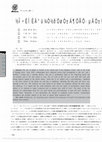Lead/silver smelting by Jianli Chen

The site of Baojia is located in the central part of the Shangrao county , 5km to the south of Xi... more The site of Baojia is located in the central part of the Shangrao county , 5km to the south of Xinjiang River. Since 2009 , archaeologists have conducted several field investigations at this site , and identified a mining and a smelting districts. The site is preliminarily dated to the Tang-Song period and was possibly used in the later period as well. The ore used at this site was vein gold with most gold bearing particles trapped in the silicate matrix , which had to be smelted with a pyro-technology. Additionally , the silver content of the Baojia ore and slag is significant , indicating that both gold and silver were extracted at this site. The relatively low lead content in the Baojia ore negatively affected the silver extraction efficiency. It is argued that the small production scale and low degree of specialisation caused Baojia smelters to be reluctant to import extraneous lead to promote their yield of silver. The study of this site enhanced our understanding about the vein gold mining and pyro-technology of gold and silver smelting in imperial China. Meanwhile , it also demonstrates the strength of combining textual research , archaeological investigation and scientific analysis in the study of ancient metal production sites .
Papers by Jianli Chen

Science in China Series E: Technological Sciences, 2009
ABSTRACT Analysis of the fabrication technology of a bronze knife with an iron blade and a bronze... more ABSTRACT Analysis of the fabrication technology of a bronze knife with an iron blade and a bronze Ge with an iron blade, two copper-iron bimetallic wares, unearthed in M27 of Liangdaicun Site, Hancheng of Shaanxi, is performed in this paper by using metallographic, EPMA and AMS-14C dating methods. The microstructures of the two samples are typical wrought bloomery iron containing a substantial amount of carbon, which is also called carburized steel, made from bloomery iron by cementation in the solid state. The objects can be dated back to the early Spring and Autumn period. This study provides new evidence for understanding the beginning of iron smelting in China. Most of the early known iron wares of the period between the late Western Zhou Dynasty and the early Spring and Autumn were unearthed in the region at the junction of Henan, Shanxi and Shaanxi, at the middle reaches of the Yellow River, suggesting that this region may likely be one of the earliest centers of iron smelting technology in China and deserves further archaeological research. As early iron products were also discovered in the area of the upper reaches of the Yellow River and in Xinjiang, appropriate attention also should be paid to the relationship between these two areas in terms of the origin of iron smelting.

Journal of Archaeological Science, 2014
ABSTRACT Iron objects excavated from the Dongheishan site provided a chance to systematically stu... more ABSTRACT Iron objects excavated from the Dongheishan site provided a chance to systematically study the iron and steel making technology during the Warring States period and the Han dynasty in the Yan region, north China. According to the results of radiocarbon dating, metallographic and slag inclusions analysis, it was found that they were made of cast iron or cast iron subsequently processed into steel, and most radiocarbon dates of iron artefacts were consistent with the determination from their archaeological context. The technology in this region was as advanced as the Central Plain China, and it was probably a previously unknown centre of technological innovation during this period. Meanwhile, the results showed that the local craftsmen used different types of iron and steel and different technologies to produce different types of objects.

Journal of Archaeological Science
Our understanding of zinc distillation technology in ancient China has traditionally been limited... more Our understanding of zinc distillation technology in ancient China has traditionally been limited by a lack of studies of production remains. The discovery of nearly 20 zinc smelting sites dated to the Ming Dynasty (AD 1368–1644) along the Yangtze River in Fengdu, Chongqing, southwest China since 2002 is allowing a detailed technological reconstruction of zinc production. This paper presents the analytical study by OM, SEM-EDS and EPMA-WDS of the production remains from three of these sites, including zinc ore, zinc metal, retorts and slag. The analytical results reveal the use of large-scale installations for zinc distillation with retorts made of pots, condensers, pockets and lids, all well designed to meet specific performance characteristics. The retorts were charged with iron-rich oxidic zinc ores, coal and charcoal; a high temperature of around 1200 °C and highly reducing atmosphere were achieved to reduce the zinc ores; the zinc vapour formed within the pots was cooled and collected in the condensers. The mass production of zinc in Fengdu was probably set up to supply governmental mints.► This is the first detailed reconstruction of zinc distillation technology in Ming China. ► Fengdu zinc smelting employed multi-component retorts with pots, condensers, pockets and lids. ► All the parts were well designed to meet specific performance characteristics. ► The pots were charged with iron-rich oxidic zinc ores, coal and charcoal. ► Zinc vapour formed within the pots at ∼1200 °C and was collected as a solid ingot in the condensers.

Journal of Archaeological Science, 2013
Piece mould casting technology, as a hall mark of the central plains of China during the Bronze A... more Piece mould casting technology, as a hall mark of the central plains of China during the Bronze Age, has attracted scholars' interest globally. Bronze ritual vessels found in this area were produced in large quantities and generally cast with the moulds composed of three or more sections. This enormous industry certainly required workers to have had professional knowledge to ensure the success of every single cast. Mould making technology was one of its most important parts. This research looks into the microstructure of bronze casting moulds of the Eastern Zhou period, which was a rarely studied topic in previous research. Through comparison with local pottery, it is shown that casting moulds in this period were produced with quite specialized sand-rich material, and clay was only a minor component. It is then discussed how this unique material can be beneficial to the bronze casting process and how this technology was integrated as a crucial part of the Chinese bronze casting system. These analyses might be able to portray mould makers in the ancient bronze foundries as a group of specialized people with their own traditions and professional knowledge.










Uploads
Lead/silver smelting by Jianli Chen
Papers by Jianli Chen